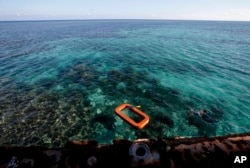ບັນດານັກຊ່ຽວຊານ ກ່າວວ່າ ຈີນໄດ້ວາງແຜນທີ່ຈະນຳສົ່ງໂຮງເຕົາປະຕິກອນ ນິວເຄຼຍທີ່ຕິດຕັ້ງຢູ່ເທິງກຳປັ່ນໄປຍັງບໍລິເວນທີ່ມີການຂັດແຍ້ງກັນ ໃນທະເລຈີນ ໃຕ້ ເຊິ່ງອາດຈະເພີ້ມຄວາມເຄັ່ງຕຶງຂຶ້ນກັບບັນດາປະເທດທີ່ອ້າງເອົາກຳມະສິດ ອື່ນໆ ແລະເປັນບ່ອນທຳລາຍຄວາມໝັ້ນຄົງຢູ່ໃນພາກພື້ນ ແລະພວກທີ່ອ້າງເອົາ ກຳມະສິດໃນເຂດດັ່ງກ່າວ ຄວນເຮັດວຽກກັບຫຼາຍຝ່າຍໂດຍຜ່ານກອບການ ດຳເນີນງານເພື່ອຕ້ານຢັນຈີນ.
ຈີນວາງແຜນທີ່ຈະສົ່ງໂຮງໄຟຟ້າພະລັງນິວເຄຼຍປະມານ 20 ໂຮງງານ ໄປຍັງ ເກາະຕ່າງໆທີ່ຕົນຖົມຂຶ້ນຢູ່ໃນທະເລຈີນໃຕ້ ບ່ອນທີ່ຕົນໄດ້ປະເຊີນກັບບັນຫາຂັດ ແຍ້ງດ້ານດິນແດນກັບປະເທດທັງຫຼາຍຢູ່ໃນພາກພື້ນມາຍາວນານ, ດັ່ງທີ່ໜັງສື ພິມ ວໍຊິງຕັນໂພສ (The Washington Post) ໄດ້ລາຍງານເມື່ອຕົ້ນເດືອນນີ້.
ຈີນອ້າງເອົາກຳມະສິດໃນທະເລຈີນໃຕ້ເກືອບທັງໝົດວ່າເປັນຂອງຕົນເອງ ເຖິງແມ່ນວ່າ ສານຕັດສິນຊີ້ຂາດຖາວອນສາກົນ ໄດ້ພິພາກສາໃນປີ 2016 ເຊິ່ງໄດ້ປະຕິເສດຕໍ່ຂໍ້ອ້າງດັ່ງກ່າວຂອງຈີນນັ້ນວ່າ “ບໍ່ມີພື້ນຖານທາງດ້ານ ກົດໝາຍ”. ສ່ວນມາເລເຊຍ ແລະໂດຍສະເພາະຫວຽດນາມ ແລະ ຟີລິບປິນ ຍັງໄດ້ອ້າງກຳມະສິດຕໍ່ໝູ່ເກາະດອນບາງສ່ວນຂອງທະເລແຫ່ງນີ້ເຊັ່ນກັນ.
ບັນດາປະເທດທີ່ອ້າງເອົາກຳມະສິດທັງຫຼາຍເຫຼົ່ານີ້ ເຫັນວ່າ ແຜນການປະຕິບັດ ງານຂອງຈີນ ໃນການນຳເອົາເຕົາປະຕິກອນທັງຫຼາຍໄປຍັງເກາະດອນນັ້ນ ເປັນ “ການທ້າທາຍໂດຍກົງ” ຕໍ່ອະທິປະໄຕຂອງພວກເຂົາເຈົ້າ ດັ່ງທີ່ ທ່ານ ປຣາດນາຊຣີ ບາຊູ ສະມາຊິກພາຄີໂຄງການສຶກສາດ້ານຍຸດທະສາດຂອງມູນ ນິທິຜູ້ສັກເກດການຄົ້ນຄວ້າ ທີ່ມີຫ້ອງການຕັ້ງຢູ່ ອິນເດຍ ໄດ້ກ່າວຕໍ່ວີໂອເອຢູ່ ໃນການຕິດຕໍ່ທາງອີເມລວ່າ, ຖ້າຫາກພວກເຕົາປະຕິກອນດັ່ງກ່າວ ໄດ້ຖືກສົ່ງ ໄປຕິດຕັ້ງ, ຕາມທີ່ພວກເຂົາອ້າງນັ້ນຫຼືບໍ່.
China’s planned deployment of floating nuclear reactors to the disputed South China Sea may risk ramping up tensions with other claimants and undermining regional security, and claimants should work through a multilateral framework to counter China, say experts.
China plans to send some 20 floating nuclear power plants to the islands it reclaimed in the South China Sea, where it has long-running territorial disputes with some regional countries, The Washington Post reported early this month.
China claims almost the entirety of the South China Sea as its own despite a ruling by the Permanent Court of Arbitration in 2016 which rejected the claim as “having no legal basis.” Malaysia, Vietnam and the Philippines also have rival claims to some island chains and parts of the sea.
These claimants view China’s planned operation of these reactors as “a direct challenge” to their sovereignty, Pratnashree Basu, associate fellow with the India-based Observer Research Foundation’s Strategic Studies Program, told VOA in an email exchange, if the reactors are deployed to islands, rocks, low-tide elevations, or man-made features they claim.







ຟໍຣັມສະແດງຄວາມຄິດເຫັນ